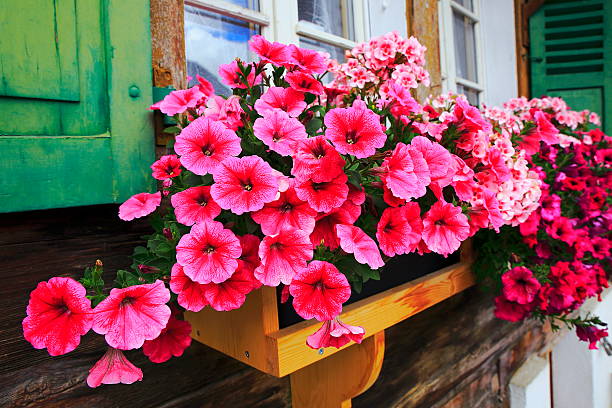Flowers have an innate ability to bring joy and beauty into our lives, and with so many different types to choose from, it’s hard to pick just one favorite. Today, we’re focusing on a specific letter of the alphabet – D. Flowers starting with D are some of the most dazzling and delightful species out there, ranging from the dramatic Delphinium to the dreamy Deadnettle. Whether you’re a seasoned gardener or simply looking to add some floral flair to your home, keep reading to discover 25 stunning flowers starting with D, that captivate and inspire you.
How To Use Dazzling Flowers Starting With D
While there are many different types of flowers, starting with D, to choose from, how you can use them are equally diverse. Here are a few ideas on how to incorporate these dazzling flowers into your life:
- Indoor Decoration: Bring the beauty of flowers, starting with D, indoors by growing them in a pot or vase. For instance, the delicate blooms of Dendrobium or Dwarf Iris can add a touch of elegance to any room, while the bold colors of Delphinium or Dahlia can make a statement in a living space.
- Outdoor Landscaping: Transform your outdoor space with the vibrant colors of flowers, starting with D. Plant species like Daffodil or Daylily in your garden or along walkways for a pop of color and texture, or use Dutch Iris or Drumstick Allium to create a striking focal point.
- Gift Giving: Whether it’s for a special occasion or just giving someone a bouquet of flowers, starting with D can be a thoughtful and meaningful gesture. Consider a bouquet of Daphne or Delphinium for a friend’s birthday, or send a potted Dendrobium as a housewarming gift.
- Aromatherapy: Many flowers starting with D, have pleasant scents that can promote relaxation and stress relief. Place a bouquet of Desert Rose or Deadnettle in your bedroom or workspace to enjoy their soothing aroma, or try burning Devil’s Tongue or Devil’s Trumpet as incense.
In conclusion, there are numerous ways to use dazzling flowers, starting with D, to enhance your life, from indoor decoration to gift-giving to aromatherapy. The possibilities are endless – all you need is a little creativity and appreciation for the beauty of nature.
1. Daffodil
Daffodils are a delightful spring-blooming flower that are widely known for their trumpet-shaped blooms and cheerful yellow and white colors. These flowers are native to Western Europe, but they can be grown successfully in many regions around the world, including the United States, Canada, Australia, and New Zealand.
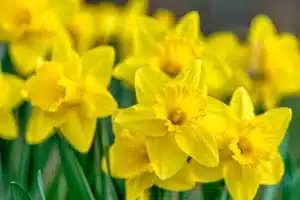
When planting daffodils, it’s important to choose a well-draining soil with plenty of organic matter. These flowers prefer a sunny location with at least 6 hours of direct sunlight per day. Daffodils can be planted in the fall or early spring, with the bulbs placed about 6 inches deep and 3-6 inches apart. It’s also important to water the bulbs thoroughly after planting to help them establish roots.
Once daffodils are established, they require very little maintenance. They prefer moderate moisture levels, so be sure not to overwater them. Deadheading spent blooms can help encourage additional growth and blooming the following year.
Daffodils are a popular flower for garden beds, borders, and containers, and can also be used in cut flower arrangements. With their easy-to-grow nature and vibrant colors, it’s no wonder they are a beloved springtime favorite around the world.
2. Dahlia
Dahlias are stunning flowers that bloom in a variety of shapes and colors, making them a popular choice for gardens and floral arrangements. These flowers are native to Mexico and Central America but are now grown in many countries, including the United States, Canada, the United Kingdom, and New Zealand.
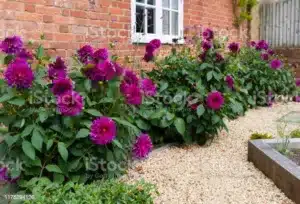
When planting dahlias, it’s important to choose a well-draining soil with plenty of organic matter. They prefer a sunny location with at least 6 hours of direct sunlight per day. Dahlias can be planted in the spring after the last frost, with the tubers placed about 4-6 inches deep and 12-18 inches apart. It’s also important to water the tubers thoroughly after planting to help them establish roots.
Once dahlias are established, they require regular watering and fertilization to promote healthy growth and blooming. Deadheading spent blooms can help encourage additional growth and blooming throughout the season. In colder climates, dahlias may need to be lifted and stored indoors during the winter months to prevent damage from freezing temperatures.
Dahlias are versatile flowers that can be used in a variety of settings, including garden beds, borders, and containers. With their vibrant colors and unique shapes, they can add a touch of elegance and charm to any garden or floral arrangement.
3. Daisy
Daisies are charming and cheerful flowers that are widely loved for their simplicity and versatility. They are native to many regions of the world, including Europe, North America, and Asia, and can be grown successfully in most temperate climates.
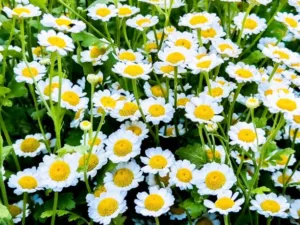
When planting daisies, it’s important to choose a well-draining soil with good fertility. They prefer a sunny location with at least 6 hours of direct sunlight per day but can also tolerate partial shade. Daisies can be planted in the spring or fall, with the seeds or seedlings placed about 8-12 inches apart. It’s also important to water the plants regularly, especially during periods of drought.
Once daisies are established, they require very little maintenance. They can tolerate a wide range of soil conditions and are resistant to most pests and diseases. Deadheading spent blooms can help encourage additional growth and blooming throughout the season.
Daisies are a popular choice for garden beds, borders, and containers, and can also be used in cut flower arrangements. With their bright colors and simple beauty, they are a timeless favorite around the world.
4. Dandelion
Dandelions are hardy and resilient flowers that are known for their bright yellow blooms and puffy white seed heads. While they are considered by some to be a weed, others appreciate their cheerful appearance and the many benefits they offer as a food source for pollinators.
Dandelions are native to Europe and Asia but can be found in many countries around the world, including the United States, Canada, and Australia. They can grow in a wide range of soil types and are tolerant of most weather conditions.
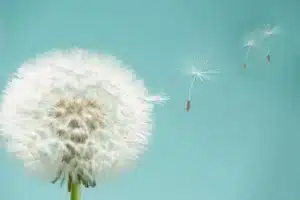
When planting dandelions, it’s important to choose a sunny location with well-draining soil. They can be grown from seeds or transplanted as seedlings, with the plants spaced about 6-12 inches apart. It’s also important to water the plants regularly, especially during periods of drought.
Once dandelions are established, they require very little maintenance. They are self-seeding and can spread quickly, so it’s important to keep them under control if growing them in a garden setting. The leaves and flowers of dandelions are also edible and can be used in a variety of recipes, from salads to teas.
While dandelions may not be everyone’s cup of tea, they are a hardy and versatile flower that can thrive in many different environments. Whether you choose to grow them for their beauty or their culinary uses, they are a unique and valuable addition to any garden.
5. Daphne
Daphne is a highly fragrant flowering shrub that is prized for its delicate blooms and sweet aroma. Native to Asia and Europe, daphne is now grown in many countries around the world, including the United States, Canada, and the United Kingdom.
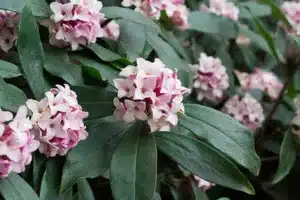
When planting daphne, it’s important to choose a well-draining soil with good fertility. They prefer a partially shaded location with protection from harsh afternoon sun. Daphne can be planted in the spring or fall, with the shrubs spaced about 3-6 feet apart. It’s also important to water the plants regularly, especially during the first few years of growth.
Once daphne is established, it requires very little maintenance. It can tolerate a wide range of soil conditions and is resistant to most pests and diseases. Deadheading spent blooms can help encourage additional growth and blooming throughout the season.
Daphne is a popular choice for garden beds, borders, and containers. Its delicate blooms and sweet fragrance make it a delightful addition to any garden or patio. However, it’s important to note that all parts of the plant are toxic if ingested, so care should be taken if planting it in a location where pets or children may come into contact with it.
6. Daylily
Daylilies are a popular and versatile flowering plant that is known for its bright blooms and low maintenance requirements. Native to Asia, daylilies are now grown in many countries around the world, including the United States, Canada, and Australia.
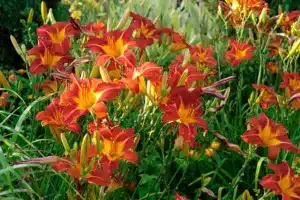
When planting daylilies, it’s important to choose a well-draining soil with good fertility. They prefer a sunny location with at least 6 hours of direct sunlight per day, but can also tolerate partial shade. Daylilies can be planted in the spring or fall, with the plants spaced about 1-3 feet apart. It’s also important to water the plants regularly, especially during periods of drought.
Once daylilies are established, they require very little maintenance. They can tolerate a wide range of soil conditions and are resistant to most pests and diseases. Deadheading spent blooms can help encourage additional growth and blooming throughout the season.
Daylilies are a popular choice for garden beds, borders, and containers, and can also be used in cut flower arrangements. With their vibrant colors and easy-to-grow nature, they are a favorite among gardeners around the world.
7. Delphinium
Delphiniums are a majestic and eye-catching flower that are known for their towering spikes of brightly colored blooms. They are native to Europe, but are now grown in many countries around the world, including the United States, Canada, and the United Kingdom.
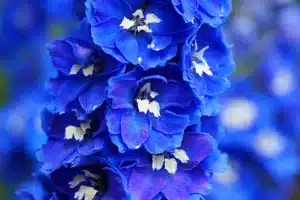
When planting delphiniums, it’s important to choose a well-draining soil with good fertility. They prefer a sunny location with at least 6 hours of direct sunlight per day, but can also tolerate partial shade. Delphiniums can be planted in the spring or fall, with the plants spaced about 1-3 feet apart. It’s also important to water the plants regularly, especially during periods of drought.
Once delphiniums are established, they require moderate watering and fertilization to promote healthy growth and blooming. Staking the tall flower stalks can also help prevent them from falling over in windy conditions. Deadheading spent blooms can help encourage additional growth and blooming throughout the season.
Delphiniums are a popular choice for garden beds, borders, and cut flower arrangements. Their dramatic spikes of colorful blooms can add a touch of elegance and sophistication to any garden or floral display. With their easy-to-grow nature and striking appearance, it’s no wonder that they are a favorite among gardeners around the world.
8. Dendrobium
Dendrobiums are a stunning orchid species that are highly valued for their colorful and intricate blooms. They are native to many countries in Southeast Asia, including Thailand, the Philippines, and Malaysia, and can be grown successfully in many other parts of the world, including the United States, Australia, and New Zealand.
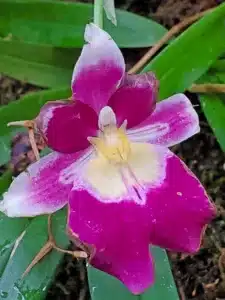
When planting dendrobiums, it’s important to choose a well-draining soil that is rich in organic matter. They prefer a bright, indirect light source and a warm, humid environment. Dendrobiums can be planted in pots or hanging baskets, with the orchids spaced about 3-4 inches apart. It’s also important to water the plants regularly, allowing the soil to dry out slightly between waterings.
Once dendrobiums are established, they require moderate watering and fertilization to promote healthy growth and blooming. It’s also important to provide good air circulation around the plants to prevent the growth of mold and mildew.
Dendrobiums are a popular choice for indoor and outdoor decoration, and can also be used in cut flower arrangements. Their delicate blooms and unique appearance make them a highly coveted orchid species around the world. With their exotic beauty and easy-to-grow nature, dendrobiums are an excellent choice for both experienced and novice gardeners alike.
9. Desert Rose
Desert roses are beautiful and unique flowering succulents that are native to arid regions of Africa and Arabia. They are now grown in many countries around the world, including the United States, Australia, and the United Kingdom.
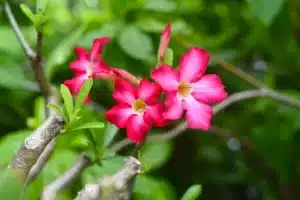
When planting desert roses, it’s important to choose a well-draining soil with good aeration. They prefer a sunny location with at least 6 hours of direct sunlight per day, and can be grown in containers or in the ground. Desert roses can be propagated from seeds or stem cuttings, and should be planted about 2-3 feet apart if grown in the ground. It’s also important to water the plants sparingly, allowing the soil to dry out completely between waterings.
Once desert roses are established, they require very little maintenance. They are highly tolerant of drought and can survive in low-nutrient soils. Fertilizing the plants with a balanced fertilizer once per month during the growing season can help promote healthy growth and blooming.
Desert roses are a popular choice for outdoor landscaping and can add a unique and exotic touch to any garden or patio. Their striking appearance and ability to thrive in harsh conditions make them a highly sought-after plant species around the world.
10. Digitalis
Digitalis, also known as foxgloves, are a beautiful and showy flower that are native to Europe and parts of Asia, but are now grown in many countries around the world, including the United States, Canada, and Australia.
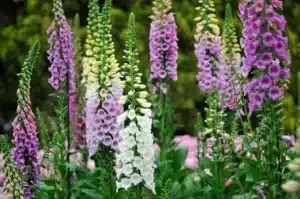
When planting digitalis, it’s important to choose a well-draining soil with good fertility. They prefer a partially shaded location with protection from harsh afternoon sun. Digitalis can be planted in the spring or fall, with the plants spaced about 1-2 feet apart. It’s also important to water the plants regularly, especially during periods of drought.
Once digitalis are established, they require moderate watering and fertilization to promote healthy growth and blooming. Deadheading spent blooms can help encourage additional growth and blooming throughout the season.
Digitalis are a popular choice for garden beds, borders, and cut flower arrangements. With their tall spikes of tubular blooms in shades of pink, white, and purple, they can add a touch of elegance and charm to any garden or floral display. However, it’s important to note that all parts of the plant are toxic if ingested, so care should be taken if planting it in a location where pets or children may come into contact with it.
11. Dogwood
Dogwoods are a beautiful and popular flowering tree that are native to many regions of the world, including North America, Asia, and Europe. They can be grown successfully in many countries around the world, including the United States, Canada, the United Kingdom, and Australia.
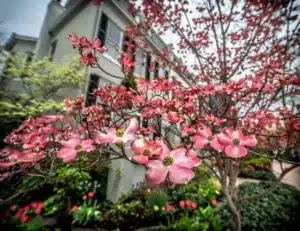
When planting dogwoods, it’s important to choose a well-draining soil with good aeration. They prefer a partially shaded location with protection from harsh afternoon sun. Dogwoods can be planted in the spring or fall, with the trees spaced about 10-20 feet apart. It’s also important to water the trees regularly, especially during periods of drought.
Once dogwoods are established, they require moderate watering and fertilization to promote healthy growth and blooming. Pruning can also help promote good tree structure and flowering.
Dogwoods are a popular choice for landscaping, and can add a touch of elegance and beauty to any yard or garden. With their delicate blooms in shades of pink, white, and red, they are a favorite among gardeners around the world. In addition to their ornamental value, they are also valued for their wood, which is used in a variety of applications, from furniture to tool handles.
12. Double Daffodil
Double daffodils are a stunning and elegant variation of the classic daffodil flower. They are native to many regions of the world, including Europe, Asia, and North America, and can be grown successfully in many countries around the world.
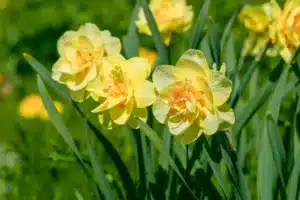
When planting double daffodils, it’s important to choose a well-draining soil with good fertility. They prefer a sunny location with at least 6 hours of direct sunlight per day. Double daffodils can be planted in the fall, with the bulbs placed about 4-6 inches deep and 4-6 inches apart. It’s also important to water the bulbs thoroughly after planting to help them establish roots.
Once double daffodils are established, they require moderate watering and fertilization to promote healthy growth and blooming. Deadheading spent blooms can help encourage additional growth and blooming throughout the season.
Double daffodils are a popular choice for garden beds, borders, and cut flower arrangements. With their large, full blooms in shades of yellow, white, and orange, they can add a touch of luxury and sophistication to any garden or floral display. Their delicate fragrance and easy-to-grow nature make them a favorite among gardeners around the world.
13. Drumstick Allium
The Drumstick Allium is a unique and eye-catching flower that is native to many regions of Europe, Asia, and Africa. It is now grown in many countries around the world, including the United States, Canada, and Australia.
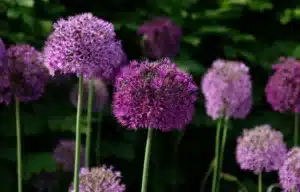
When planting Drumstick Allium, it’s important to choose a well-draining soil with good aeration. They prefer a sunny location with at least 6 hours of direct sunlight per day, but can also tolerate partial shade. Drumstick Allium can be planted in the fall, with the bulbs placed about 2-3 inches deep and 4-6 inches apart. It’s also important to water the bulbs thoroughly after planting to help them establish roots.
Once Drumstick Allium is established, it requires very little maintenance. They are highly tolerant of drought and can survive in low-nutrient soils. Deadheading spent blooms can help encourage additional growth and blooming throughout the season.
Drumstick Allium is a popular choice for garden beds and borders, and can add a unique and exotic touch to any garden or patio. Their tall, slender stems topped with small, spherical blooms in shades of pink and purple make them a highly coveted flower species around the world. With their easy-to-grow nature and striking appearance, Drumstick Allium is an excellent choice for both experienced and novice gardeners alike.
14. Dutch Iris
Dutch irises are a vibrant and colorful flower that are native to many regions of Europe, Asia, and North Africa. They can be grown successfully in many countries around the world, including the United States, Canada, the United Kingdom, and Australia.
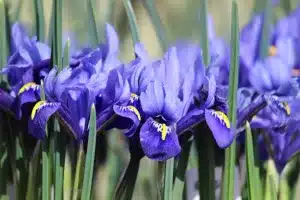
When planting Dutch irises, it’s important to choose a well-draining soil with good fertility. They prefer a sunny location with at least 6 hours of direct sunlight per day. Dutch irises can be planted in the fall, with the bulbs placed about 4-6 inches deep and 3-4 inches apart. It’s also important to water the bulbs thoroughly after planting to help them establish roots.
Once Dutch irises are established, they require moderate watering and fertilization to promote healthy growth and blooming. Deadheading spent blooms can help encourage additional growth and blooming throughout the season.
Dutch irises are a popular choice for garden beds, borders, and cut flower arrangements. With their tall, slender stems topped with bold, brightly colored blooms in shades of blue, purple, white, and yellow, they can add a touch of elegance and sophistication to any garden or floral display. Their easy-to-grow nature and wide range of colors make them a favorite among gardeners around the world.
15. Dwarf Iris
Dwarf irises are a charming and delicate flower that are native to many regions of Europe, Asia, and North America. They can be grown successfully in many countries around the world, including the United States, Canada, the United Kingdom, and Australia.
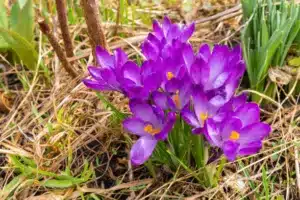
When planting dwarf irises, it’s important to choose a well-draining soil with good fertility. They prefer a sunny location with at least 6 hours of direct sunlight per day. Dwarf irises can be planted in the fall, with the bulbs placed about 2-3 inches deep and 3-4 inches apart. It’s also important to water the bulbs thoroughly after planting to help them establish roots.
Once dwarf irises are established, they require moderate watering and fertilization to promote healthy growth and blooming. Deadheading spent blooms can help encourage additional growth and blooming throughout the season.
Dwarf irises are a popular choice for rock gardens, border edging, and containers. With their small, delicate blooms in shades of blue, purple, yellow, and white, they can add a touch of whimsy and charm to any garden or floral display. Their easy-to-grow nature and small size make them a favorite among gardeners around the world.
16. Dusty Miller
Dusty miller is a beautiful and distinctive plant that is native to the Mediterranean region, but can be grown successfully in many countries around the world, including the United States, Canada, and Australia.
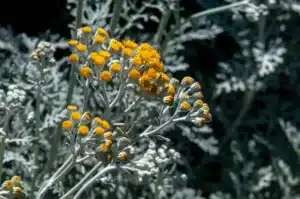
When planting dusty miller, it’s important to choose a well-draining soil with good fertility. They prefer a sunny location with at least 6 hours of direct sunlight per day, but can also tolerate partial shade. Dusty miller can be planted in the spring, with the plants spaced about 1-2 feet apart. It’s also important to water the plants regularly, especially during periods of drought.
Once dusty miller is established, it requires very little maintenance. They are highly tolerant of drought and can survive in low-nutrient soils. Pinching back the growing tips can help promote bushier growth and a fuller appearance.
Dusty miller is a popular choice for border edging, container gardening, and as a filler plant in mixed plantings. With their silvery-gray foliage, they can add a touch of elegance and texture to any garden or floral display. Their easy-to-grow nature and unique appearance make them a favorite among gardeners around the world.
17. Dutchman’s Breeches
Dutchman’s breeches, also known as Dicentra cucullaria, is a charming and unique flowering plant that is native to eastern North America. It can be grown successfully in many countries around the world, including the United States, Canada, the United Kingdom, and Australia.
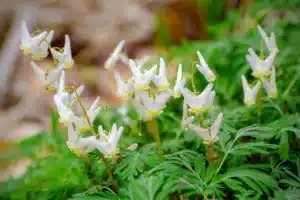
When planting Dutchman’s breeches, it’s important to choose a well-draining soil with good aeration. They prefer a partially shaded location with protection from harsh afternoon sun. Dutchman’s breeches can be planted in the fall, with the bulbs placed about 3-4 inches deep and 4-6 inches apart. It’s also important to water the bulbs thoroughly after planting to help them establish roots.
Once Dutchman’s breeches are established, they require moderate watering and fertilization to promote healthy growth and blooming. Deadheading spent blooms can help encourage additional growth and blooming throughout the season.
Dutchman’s breeches are a popular choice for woodland gardens, shaded borders, and naturalized settings. With their delicate, white or pink, pantaloons-shaped flowers, they can add a touch of whimsy and charm to any garden or natural area. Their easy-to-grow nature and unique appearance make them a favorite among gardeners around the world.
18. Devil’s Paintbrush
Devil’s paintbrush, also known as Hieracium aurantiacum, is a striking and vivid flowering plant that is native to Europe and parts of Asia. It can be grown successfully in many countries around the world, including the United States, Canada, and Australia.
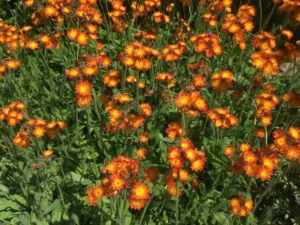
When planting Devil’s paintbrush, it’s important to choose a well-draining soil with good aeration. They prefer a sunny location with at least 6 hours of direct sunlight per day. Devil’s paintbrush can be planted in the spring or fall, with the plants spaced about 1-2 feet apart. It’s also important to water the plants regularly, especially during periods of drought.
Once Devil’s paintbrush is established, it requires very little maintenance. They are highly tolerant of drought and can survive in low-nutrient soils. Deadheading spent blooms can help encourage additional growth and blooming throughout the season.
Devil’s paintbrush is a popular choice for wildflower meadows, naturalized areas, and as a striking accent plant in garden beds and borders. With their tall, slender stems topped with bright orange-red, daisy-like flowers, they can add a touch of drama and color to any garden or natural setting. Their easy-to-grow nature and bold appearance make them a favorite among gardeners around the world.
19. Devil’s Trumpet
Devil’s trumpet, also known as Brugmansia, is a beautiful and exotic flowering plant that is native to South America. It can be grown successfully in many countries around the world, including the United States, Canada, the United Kingdom, and Australia.
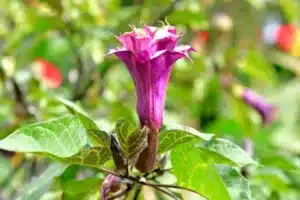
When planting Devil’s trumpet, it’s important to choose a well-draining soil with good fertility. They prefer a sunny location with at least 6 hours of direct sunlight per day. Devil’s trumpet can be planted in the spring or fall, with the plants spaced about 3-6 feet apart. It’s also important to water the plants regularly, especially during periods of drought.
Once Devil’s trumpet is established, it requires moderate watering and fertilization to promote healthy growth and blooming. Pruning can also help maintain a desirable shape and promote additional blooming.
Devil’s trumpet is a popular choice for tropical gardens, patio containers, and as a specimen plant in garden beds and borders. With their large, trumpet-shaped flowers in shades of white, yellow, pink, and orange, they can add a touch of exotic beauty to any garden or patio. However, it’s important to note that all parts of the plant are toxic and should be kept away from children and pets. Their easy-to-grow nature and unique appearance make them a favorite among gardeners around the world.
20. Devil’s Tongue
Devil’s tongue, also known as Amorphophallus konjac, is an unusual and intriguing plant that is native to Southeast Asia. It can be grown successfully in many countries around the world, including the United States, Canada, and Australia.
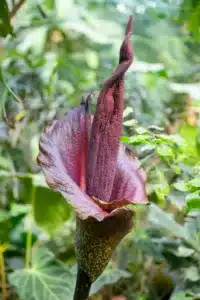
When planting devil’s tongue, it’s important to choose a well-draining soil with good aeration. They prefer a partially shaded location with protection from harsh afternoon sun. Devil’s tongue can be planted in the spring, with the corms (bulbs) placed about 2-3 inches deep and 12-18 inches apart. It’s also important to water the corms thoroughly after planting to help them establish roots.
Once devil’s tongue is established, it requires moderate watering and fertilization to promote healthy growth. The plant can grow quite large, up to 4 feet tall, and will require staking or support to keep the stem upright. During the summer months, the plant produces a large, exotic-looking flower.
Devil’s tongue is a popular choice for tropical gardens, as well as indoor plant collections. With their unique and exotic appearance, they can add a touch of drama and intrigue to any setting. Their easy-to-grow nature and fascinating growth habits make them a favorite among gardeners around the world.
21. Deadnettle
Deadnettle, also known as Lamium, is a hardy and versatile plant that is native to Europe and Asia, but can be grown successfully in many countries around the world, including the United States, Canada, the United Kingdom, and Australia.
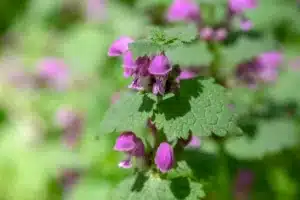
When planting deadnettle, it’s important to choose a well-draining soil with good fertility. They prefer a partially shaded location with protection from harsh afternoon sun. Deadnettle can be planted in the spring or fall, with the plants spaced about 1-2 feet apart. It’s also important to water the plants regularly, especially during periods of drought.
Once deadnettle is established, it requires moderate watering and fertilization to promote healthy growth and blooming. Deadheading spent blooms can help encourage additional growth and blooming throughout the season.
Deadnettle is a popular choice for groundcovers, border edging, and container gardening. With their small, vibrant flowers in shades of pink, purple, and white, they can add a touch of charm and color to any garden or patio. Their easy-to-grow nature and tolerance of different growing conditions make them a favorite among gardeners around the world.
22. Dutch Hyacinth
Dutch Hyacinth, also known as Hyacinthus Orientalis, is a fragrant and vibrant flowering plant that is native to the eastern Mediterranean region but can be grown successfully in many countries around the world, including the United States, Canada, the United Kingdom, and Australia.
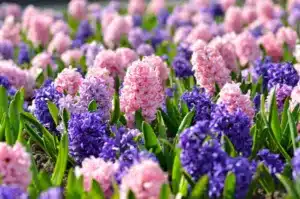
When planting Dutch Hyacinths, it’s important to choose a well-draining soil with good fertility. They prefer a sunny location with at least 6 hours of direct sunlight per day. Dutch Hyacinths can be planted in the fall, with the bulbs placed about 4-6 inches deep and 3-4 inches apart. It’s also important to water the bulbs thoroughly after planting to help them establish roots.
Once Dutch Hyacinths are established, they require moderate watering and fertilization to promote healthy growth and blooming. Deadheading spent blooms can help encourage additional growth and blooming throughout the season.
Dutch Hyacinths are a popular choice for garden beds, borders, and cut flower arrangements. With their tall, slender stems topped with densely packed, fragrant flowers in shades of blue, purple, pink, and white, they can add a touch of elegance and sophistication to any garden or floral display. Their easy-to-grow nature and wide range of colors make them a favorite among gardeners around the world.
23. Darlingtonia Californica
Darlingtonia californica, also known as the California pitcher plant, is a fascinating and unique carnivorous plant that is native to northern California and southern Oregon in the United States.
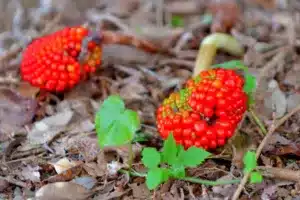
When planting Darlingtonia californica, it’s important to choose a soil that is low in nutrients and high in organic matter. They prefer a partially shaded location with protection from harsh afternoon sun. California pitcher plants can be planted in the spring or fall, with the plants spaced about 6-8 inches apart. It’s also important to water the plants with distilled water or rainwater, as tap water can contain minerals that are harmful to carnivorous plants.
Once Darlingtonia californica is established, it requires very little maintenance. They are able to obtain their nutrients from the insects they capture in their pitcher-like leaves. It’s important to keep the pitchers filled with water, as this is where the insects will be trapped.
Darlingtonia californica is a popular choice for bog gardens, container gardening, and as a unique accent plant in garden beds and borders. With their unusual, tube-shaped leaves that resemble the head of a cobra, they can add a touch of intrigue and interest to any garden or patio. Their status as a carnivorous plant makes them a favorite among collectors and enthusiasts around the world.
24. Dragon Arum
Dragon Arum, also known as Dracunculus vulgaris, is a striking and unique flowering plant that is native to the Mediterranean region, but can be grown successfully in many countries around the world, including the United States, Canada, and the United Kingdom.
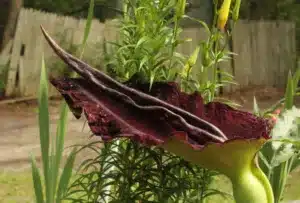
When planting Dragon Arum, it’s important to choose a well-draining soil with good fertility. They prefer a partially shaded location with protection from harsh afternoon sun. Dragon Arum can be planted in the fall or spring, with the corms (bulbs) placed about 4-6 inches deep and 8-12 inches apart. It’s also important to water the corms thoroughly after planting to help them establish roots.
Once Dragon Arum is established, it requires moderate watering and fertilization to promote healthy growth and blooming. It’s important to note that the plant produces a strong odor that resembles rotting flesh, which is attractive to the flies that pollinate the flowers.
Dragon Arum is a popular choice for shady gardens, woodland settings, and as a unique accent plant in garden beds and borders. With their unusual, large, maroon or brown flowers surrounded by a green, leaf-like bract, they can add a touch of intrigue and exoticism to any garden or natural setting. Their easy-to-grow nature and unique appearance make them a favorite among gardeners around the world.
25. Duranta
Duranta is a beautiful and versatile flowering plant that is native to tropical regions of the Americas, but can be grown successfully in many countries around the world, including the United States, Canada, the United Kingdom, and Australia.
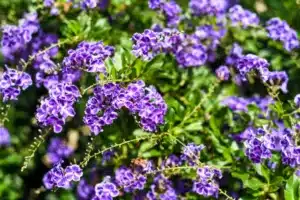
When planting Duranta, it’s important to choose a well-draining soil with good fertility. They prefer a sunny location with at least 6 hours of direct sunlight per day, although they can tolerate partial shade in hotter climates. Duranta can be planted in the spring or fall, with the plants spaced about 3-4 feet apart. It’s also important to water the plants regularly, especially during periods of drought.
Once Duranta is established, it requires moderate watering and fertilization to promote healthy growth and blooming. The plant can grow quite large, up to 15 feet tall, so it may require pruning to maintain a desirable shape and size.
Duranta is a popular choice for tropical gardens, container gardening, and as a colorful accent plant in garden beds and borders. With their delicate, star-shaped flowers in shades of blue, purple, and white, they can add a touch of beauty and charm to any garden or patio. Their easy-to-grow nature and tolerance of different growing conditions make them a favorite among gardeners around the world.
Final Dirt On Flowers Starting With D
These 25 dazzling flowers starting with D are just a few of the many beautiful and diverse options available to gardeners and flower enthusiasts. Whether you prefer bold and vibrant blooms or delicate and subtle flowers, there is a D flower for every taste and preference. By incorporating these flowers into your garden or indoor space, you can add color, beauty, and fragrance to your surroundings and create a peaceful and inviting atmosphere. So don’t hesitate to explore the world of D flowers and discover your new favorites today!

Hi there, I’m Mark Apletree, a gardening enthusiast with a passion for gardening, and gardening tools. I’ll be your go-to guide for all things related to gardening. The purpose of this website is to assist you in selecting the most suitable garden gear that meets your specific requirements.
See All Posts
